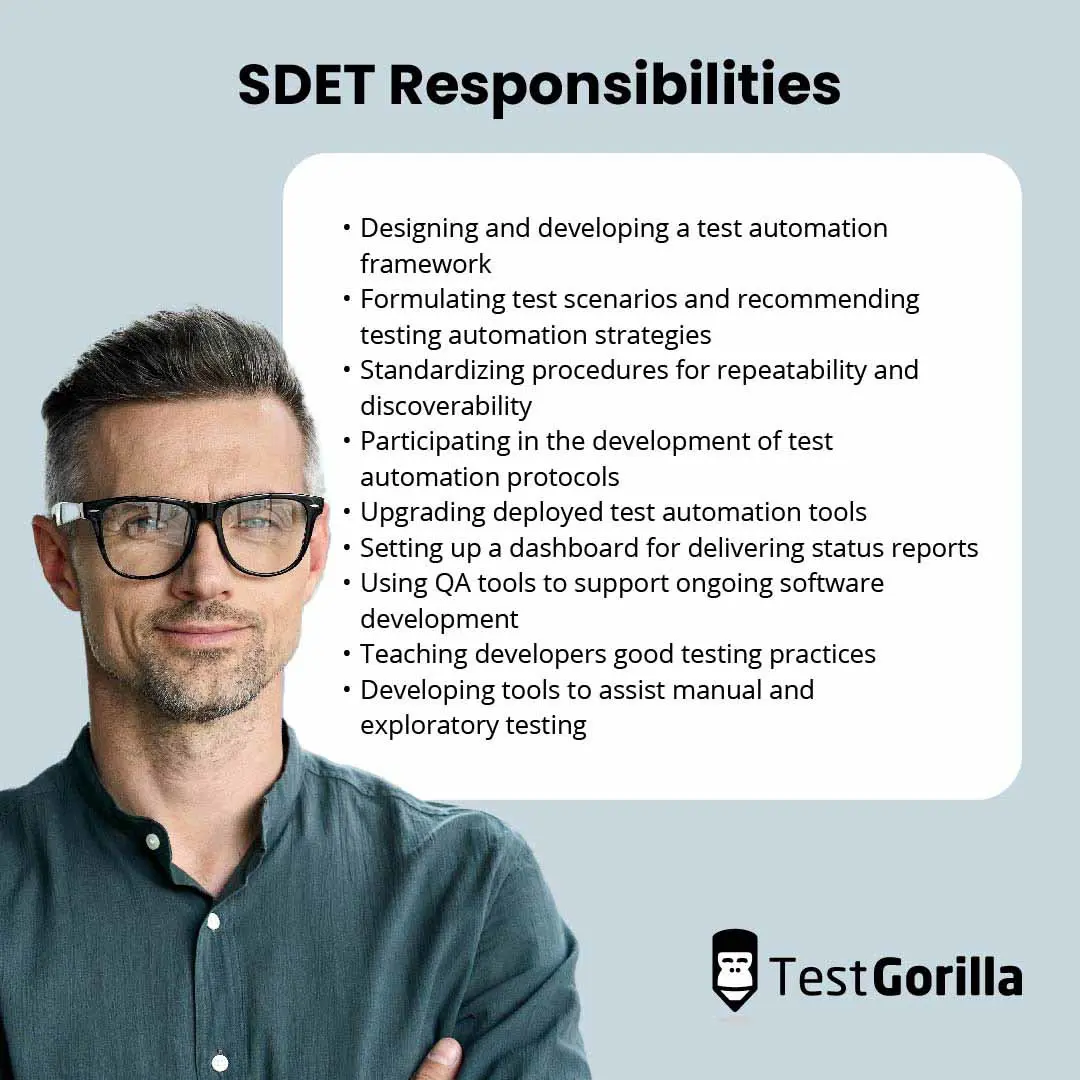A software development engineer in test (SDET) is a developer whose primary responsibility is writing frameworks and tools for testing software products. This job role falls within the software testing and quality assurance (QA) domain.
For tech companies, testing code is equally as important as programming code.
SDETs are involved in all phases of the software-development life cycle and work closely with software developers to identify and fix bugs.
Table of contents
What do SDET engineers do?
SDET engineers are essentially a mix of software developers and quality assurance (QA) testers. They are not the same as traditional QA testers, who manually test applications using written testing plans. SDETs are experts who create the tools used to automatically run tests.
Although software testers have existed for decades, the term “SDET” is relatively new. The role first became distinct in the 2000s, when large-scale test automation became necessary. Google, for example, has its own name for the role – test engineers (TE).
The SDET role is a hybrid that combines software development and testing skills. An SDET understands the application from the end user’s point of view as well as the product and domain perspectives. They fill the gap between developers and traditional testers because development and testing are different skills that require different ways of thinking.
SDETs have a tester mindset that’s critical in a test-driven development environment. They participate in QA activities and are responsible for writing all manner of automated tests, including automated integration tests, application programming interface (API) tests, and user interface (UI) automation tests. They also help review any unit tests written by developers.
Responsibilities of SDETs
Test automation involves so much more than just “writing test scripts,” and it’s important to clearly define SDETs’ responsibilities in their job description.
Your company may have specific needs, but in general, SDETs are responsible for the following areas:
Designing and developing a test automation framework that is closely linked to the delivery pipeline
Formulating test scenarios and recommending testing automation strategies using best practices
Standardizing procedures for repeatability and discoverability of software issues
Participating in the development of test automation protocols, standards, and practices for the company
Upgrading deployed test automation tools as needed
Setting up a dashboard for delivering status reports
Using QA tools to support ongoing software development, deployment, and maintenance efforts
Teaching developers good testing practices
Developing tools to assist manual and exploratory testing
Essential technical and non-technical skills for SDET engineers
An SDET engineer plays a key role at every stage of the software-development life cycle. They must review every build function in the pipeline, run it through a variety of tests, and document the software’s response.
This requires technical skills, a strong understanding of QA principles, and a good testing aptitude. Below are some of the technical and non-technical job-related skills to look for when hiring SDETs.
Technical skills
1. Programming skills
Although SDETs don’t necessarily need to code often, they must be able to speak the same language as developers and know enough to make changes and interact with an application as if they were a developer themselves. They should be able to code in at least one programming or scripting language (Java, JavaScript, C#, C++, etc).
2. Develop, optimize, and maintain CI/CD pipelines
Continuous integration and continuous deployment (CI/CD) pipelines tend to involve a lot of testing. An SDET should be able to use different test suites that are optimized to provide good test coverage and quick developer feedback. They should also know how to improve a CI/CD pipeline’s reporting to provide readable and actionable information about any failed tests.
3. Knowledge of testing principles and methodologies
An SDET should know the difference between testing and QA. They should also understand that all testing is exploratory in nature and appreciate the difference between testing and checking.
4. Knowledge of modern web applications
This includes knowledge of HTTP, how modern web applications interact with APIs, and how the web works in general.
5. Ability to write automated tests
This is a big one. An SDET should know how to write UIs as well as automated API tests.
6. Experience with testing tools and frameworks
An SDET should be able to use tools like Gatling and/or JMeter to write performance test scripts.
7. Experience with cloud platform providers
The best SDETs know how to work with cloud platform providers like Google Cloud, Amazon Web Services (AWS), and Azure.
8. Knowledge of version control and Git
This includes pull requests, branching, etc.
9. Experience with security
An SDET should think about security and be aware of the Open Web Application Security Project (OWASP), which is a nonprofit foundation working to improve the security of software. In addition to performance testing and load testing, a good SDET should also have a working knowledge of security testing.
Nontechnical skills
1. Communication
An SDET should be able to communicate basic and somewhat complex information in understandable terms to both technical and non-technical audiences. They must also be capable of shepherding developers in the right direction by using the same language they use.
2. Critical thinking
Skilled SDET engineers can critically evaluate an application for errors and stability and identify any system flaws.
3. Problem-solving
An SDET should be able to anticipate and solve problems quickly and efficiently within the company’s organizational structure.
4. Teamwork
The ideal candidate can comfortably interact with peers, management, and senior-level staff in other departments to solve test-automation issues and problems with assigned applications.
SDET salary expectations
The salary expectations of an SDET engineer depend on their experience, skills, education, and location.
According to PayScale, the average total compensation for an SDET in the US with less than one year of experience is $71,215
Mid-career SDETs with five to nine years of experience earn an average total compensation of $100,984
experienced SDETs with 10 to 19 years under their belt earn an average total compensation of $116,273.
The highest you can expect to pay an SDET based on PayScale’s data is $128,000 a year, and the lowest is $61,000 a year.
Evaluate top SDET engineers using TestGorilla’s skills tests
The range of skills expected of a good SDET is quite broad. Luckily, you can measure an SDET engineer’s technical and non-technical aptitude using skills testing.
TestGorilla’s Software Engineer test will evaluate your candidates’ knowledge of entry-level software engineering.
But you don’t have to limit your candidates to just one skills test. Why not use TestGorilla to create an assessment with up to five different skills tests to assess specific skills you’re looking for in applicants?
At TestGorilla, we have a comprehensive library of skills tests. Check it out and browse through the six different test types, which cover technical skills and soft skills.
Once your candidates have taken your chosen tests, we make it easy for you to receive the results. This enables you to quickly rank candidates based on their scores, making it easy for you to identify top performers for the interview stage.
Skills testing for your open roles is simple, fast, and more accurate than traditional hiring methods such as CV screening.
Sign up to get started for free today and identify qualified SDET engineers using a faster, unbiased hiring process.
If you want to learn more about how TestGorilla can benefit your organization, book a 30-minute free live demo with a member of our sales team today.
Related posts
Hire the best candidates with TestGorilla
Create pre-employment assessments in minutes to screen candidates, save time, and hire the best talent.
Latest posts
The best advice in pre-employment testing, in your inbox.
No spam. Unsubscribe at any time.

Hire the best. No bias. No stress.
Our screening tests identify the best candidates and make your hiring decisions faster, easier, and bias-free.
Free resources
This checklist covers key features you should look for when choosing a skills testing platform
This resource will help you develop an onboarding checklist for new hires.
How to assess your candidates' attention to detail.
Learn how to get human resources certified through HRCI or SHRM.
Learn how you can improve the level of talent at your company.
Learn how CapitalT reduced hiring bias with online skills assessments.
Learn how to make the resume process more efficient and more effective.
Improve your hiring strategy with these 7 critical recruitment metrics.
Learn how Sukhi decreased time spent reviewing resumes by 83%!
Hire more efficiently with these hacks that 99% of recruiters aren't using.
Make a business case for diversity and inclusion initiatives with this data.


















